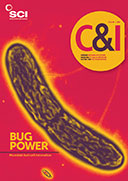Many vaccines comprise proteins or protein fragments that degrade at room temperature. Their storage and distribution demands continuous refrigeration, which is costly, not always effective and especially problematic in developing countries. Millions of doses are lost each year.
Now, chemists at the University of Bath have shown how silica cages can protect the fragile proteins, potentially prolonging their shelf life. ‘What breaks up the structure of the protein is not a chemical reaction. It’s a physical unfolding, so it seemed sensible that if we physically trapped a protein in a little cage of silica it wouldn’t unravel,’ explains Stephen Wells, lead paper author.
Silica cages encasing hen egg white lysozyme and horse haemoglobin were tested by heating them to 100°C, and by leaving the samples for up to six months at room temperature. The scientists also showed that a complex tetanus toxin fragment could be shielded in this way (Scientific Reports, doi: 10.1038/srep46568).
The method requires a silica precursor which interacts with the protein due to charge-charge interactions; silica ions move towards charged and polar parts. Hydrogen bonds form between the silica units and the protein, while the silica polymerises as a hard shell around the folded protein.
The best precursor material was pre-hydrolysed tetraethylorthosilicate (TEOS), added to a protein solution. Silica encasement renders the protein thermally stable by physically blocking protein denaturation and unfolding. The coating can be removed chemically with an acidic fluoride solution, leaving the proteins unaffected.
‘Fluoride ions have a strong chemical affinity for silica,’ says Wells. ‘[Paleontologists] use mild fluoride solution to etch silica away from fossils.’
The group is looking at whether mechanical treatment will shake off the silica, or if it could be digested away to release an intact protein in the intestine. The next research phase, however, is to extract the tetanus fragment from its silica shell and inject it into mice to see if it elicits the same immune response as a fresh fragment. This work is being done with immunologist Kevin Marchbank at the University of Newcastle.
‘It looks like it could be relatively straightforward to execute under Good Manufacturing Practice conditions needed for vaccine manufacture, including potentially at large scale,’ notes microbiologist Sandy Douglas at the University of Oxford. He praises the resilience of the proteins in the face of ‘really quite extreme heating.’
Douglas has worked on drying live viral vaccines on a membrane. He says the vaccine antigen used, tetanus toxoid is ‘quite an easy test case’ owing to its stability, but notes that live viruses in many vaccines are more difficult to stabilise than proteins.
‘It would take a number of years and seven-figure funding to make a pharmaceutical grade product suitable for early phase human testing using this approach,’ he predicts. Past efforts to protect vaccines have tried freeze-drying, biomineralisation and encapsulation in sugars and organic polymers.





